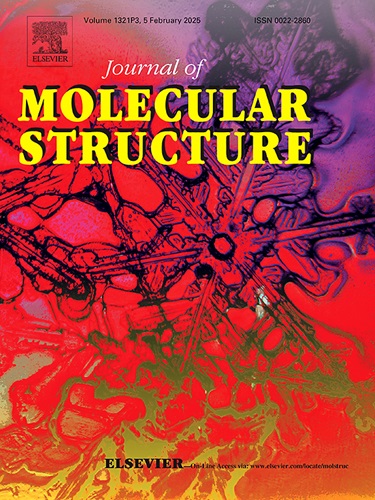Charge transfer properties of diarylamine-substituted phenyl osmium(II) compounds
IF 4
2区 化学
Q2 CHEMISTRY, PHYSICAL
引用次数: 0
Abstract
The localization or delocalization of charges and charge transfer characteristics in organometallic complexes, have consistently been significant areas of research. In this study, we investigate the charge distribution and transfer properties of four organometallic complexes containing Os(II) and triarylamine (NAr3) ligands. These compounds display dual single-electron oxidation waves: the initial oxidation involves the NAr2 unit and π(C6H3) segment, followed by a subsequent process primarily centered on Os(II) and π(C6H3). The oxidation potential and reversibility of these compounds within this series are contingent upon the positioning of the NAr2 acceptor and the Os(II) donor on the benzene ring, along with their mutual interactions. Through ultraviolet-visible-near-infrared (UV–Vis-NIR) absorption spectroscopy, observable charge transfer metal-to-ligand charge transfer (MLCT) absorptions from ClOs to NAr2+ and distinct absorption features of NAr2‧+ are identified. Notably, ligand-to-ligand charge transfer (LLCT) band emerges in the para isomer (Cl→NAr2+) and in the metamer (π(PMe3–ClOs−C6H3)→ NAr2+). Furthermore, density functional theory (DFT) and time-dependent density functional theory (TD-DFT) calculations are in agreement with the results obtained from electrochemical experiments, electronic properties, and optical behavior.
二芳胺取代苯锇(II)化合物的电荷转移性质
有机金属配合物中电荷的局域化或非局域化以及电荷转移特性一直是重要的研究领域。在这项研究中,我们研究了四种含有Os(II)和三芳胺(NAr3)配体的有机金属配合物的电荷分布和转移性质。这些化合物表现出双单电子氧化波:初始氧化涉及到NAr2单元和π(C6H3)段,随后的氧化过程主要以Os(II)和π(C6H3)为中心。该系列化合物的氧化电位和可逆性取决于NAr2受体和Os(II)给体在苯环上的位置以及它们之间的相互作用。通过紫外-可见-近红外(UV-Vis-NIR)吸收光谱,确定了ClOs对NAr2+的电荷转移金属-配体电荷转移(MLCT)吸收和NAr2·+的明显吸收特征。配体-配体电荷转移(LLCT)带出现在对异构体(Cl→NAr2+)和元异构体(π(PMe3-ClOs−C6H3)→NAr2+)中。此外,密度泛函理论(DFT)和时变密度泛函理论(TD-DFT)的计算结果与电化学实验、电子性质和光学行为的结果一致。
本文章由计算机程序翻译,如有差异,请以英文原文为准。
求助全文
约1分钟内获得全文
求助全文
来源期刊

Journal of Molecular Structure
化学-物理化学
CiteScore
7.10
自引率
15.80%
发文量
2384
审稿时长
45 days
期刊介绍:
The Journal of Molecular Structure is dedicated to the publication of full-length articles and review papers, providing important new structural information on all types of chemical species including:
• Stable and unstable molecules in all types of environments (vapour, molecular beam, liquid, solution, liquid crystal, solid state, matrix-isolated, surface-absorbed etc.)
• Chemical intermediates
• Molecules in excited states
• Biological molecules
• Polymers.
The methods used may include any combination of spectroscopic and non-spectroscopic techniques, for example:
• Infrared spectroscopy (mid, far, near)
• Raman spectroscopy and non-linear Raman methods (CARS, etc.)
• Electronic absorption spectroscopy
• Optical rotatory dispersion and circular dichroism
• Fluorescence and phosphorescence techniques
• Electron spectroscopies (PES, XPS), EXAFS, etc.
• Microwave spectroscopy
• Electron diffraction
• NMR and ESR spectroscopies
• Mössbauer spectroscopy
• X-ray crystallography
• Charge Density Analyses
• Computational Studies (supplementing experimental methods)
We encourage publications combining theoretical and experimental approaches. The structural insights gained by the studies should be correlated with the properties, activity and/ or reactivity of the molecule under investigation and the relevance of this molecule and its implications should be discussed.
 求助内容:
求助内容: 应助结果提醒方式:
应助结果提醒方式:


